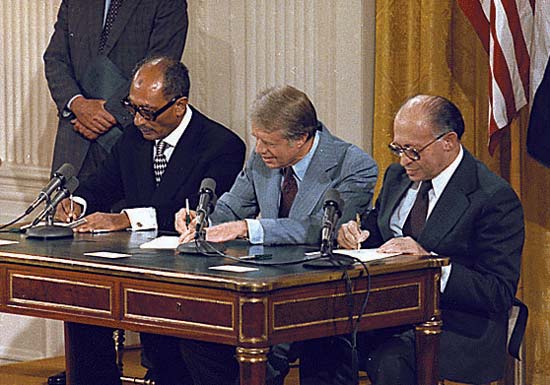Learn It Part 2
Example #2 - Cause-and-Effect Organization
Background: Following the end of World War II, the world focused on territory that had become regularly involved in tension and violence. The Middle East had become a place of competition for political, economic and religious control over the people and resources of the region. In 1978, U.S. President Jimmy Carter hosted a conference between the leaders of Egypt and Israel, two nations that had fought wars over control of one another’s territory in the Middle East. The Camp David Accords resulted, in which these two nations agreed on several issues, including respect for one another’s independence. The Camp David Accords document reflected efforts to promote peace in this volatile region.

In 1978, President Jimmy Carter helped leaders of Egypt and Israel come to agreement on issues of respect and independence.
Let’s take a look at two passages from the Camp David Accords and examine how the document is organized.
“After four wars during 30 years, despite intensive human efforts, the Middle East, which is the cradle of civilization and the birthplace of three great religions, does not enjoy the blessings of peace. The people of the Middle East yearn for peace so that the vast human and natural resources of the region can be turned to the pursuits of peace and so that this area can become a model for coexistence and cooperation among nations.”
“Taking these factors into account, the parties are determined to reach a just, comprehensive, and durable settlement of the Middle East conflict through the conclusion of peace treaties … Their purpose is to achieve peace and good neighborly relations. They recognize that for peace to endure, it must involve all those who have been most deeply affected by the conflict. They therefore agree that this framework, as appropriate, is intended by them to constitute a basis for peace not only between Egypt and Israel, but also between Israel and each of its other neighbors which is prepared to negotiate peace with Israel on this basis.”
— Camp David Accords, September 17, 1978
Source: Yale Library Avalon Project Opens a new window
The excerpts from the Camp David Accords describe the causes that have led to agreements between Israel and surrounding nations, and then introduce these documents as an effect of the tensions and problems, in this example:
“The ‘good neighborly relations’ are a result of the lack of enjoyment of ‘the blessings of peace.’”
The cause-and-effect organization provides an introduction and central idea of the purpose of the document. Showing both the causes of the tension and the effect it was having on problems between nations was an important start to the document.
Example #3 - Comparative Organization
Background: In the latter part of the twentieth century, the world had finally entered a period of relative peace. In January 1993, newly elected President Bill Clinton addressed the nation and world in his first Inaugural Address.
Let’s take a look at President Clinton’s First Inaugural Address and examine how the text is presented.
“When George Washington first took the oath I have just sworn to uphold, news traveled slowly across the land by horseback and across the ocean by boat. Now, the sights and sounds of this ceremony are broadcast instantaneously to billions around the world.
Communications and commerce are global; investment is mobile; technology is almost magical; and ambition for a better life is now universal. We earn our livelihood in peaceful competition with people all across the earth.
Profound and powerful forces are shaking and remaking our world, and the urgent question of our time is whether we can make change our friend and not our enemy.”
— President Bill Clinton’s First Inaugural Address, January 1993
Source: Yale Library Avalon Project Opens a new window
The excerpt from Clinton’s Inaugural Address uses a series of comparisons to introduce the new president’s outlook on the challenges facing the United States. President Clinton compares communication and commerce to the time when the nation’s first president, George Washington, became president over 200 years earlier. Using this comparative organization, the document gives the audience an idea of how the nation has grown and how this progress also creates challenges at the end of the twentieth century.


